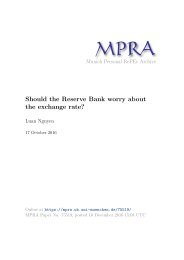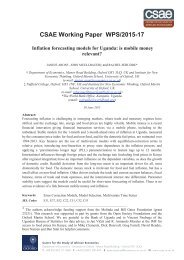debtequity
n?u=RePEc:red:sed016:1511&r=cba
n?u=RePEc:red:sed016:1511&r=cba
Create successful ePaper yourself
Turn your PDF publications into a flip-book with our unique Google optimized e-Paper software.
We do not consider the case R c > R E for which c i > 0 and e = 0, since banks must have positive<br />
equity in equilibrium. If R E = R c then we assume investors only invest in equity (i.e. c i = 0) and<br />
this is without loss of generality under assumptions that we will introduce shortly.<br />
There is a unit mass of each of the three types of agents and a unit mass of banks, to which we<br />
now turn our attention.<br />
Banks<br />
Banks collect the deposits (d), the equity (e) and a part (c b ) of the lending of cash funds<br />
(the rest finances the government) and invest the proceeds K = d + e + c b in risky projects with<br />
payoff ã per unit of capital at date 1. The random variable ã is as described in Section 2 with<br />
support on the interval [a, ∞) and with continuous density f(a) extended to the interval [0, ∞). The<br />
safe part Ka of their date 1 payoff can be interpreted as the safe component which can be pledged as<br />
collateral for borrowing from cash funds (akin to the senior tranche of the banks securitized assets).<br />
Cash funds will lend an amount in excess of this sure component i.e. R c c b > Ka only if they are<br />
sure to recover their funds. In this section we consider two possibilities, with or without implicit<br />
insurance for the cash funds. If there is implicit insurance, cash funds believe that the government<br />
will reimburse their loans if the banks default and this belief is realized. In this case they may<br />
accept to lend more than the value of the safe collateral Ka, i.e. they accept risky collateral. We<br />
call the insurance "implicit" because there is no explicit contract or insurance premium attached to<br />
it. An example of implicit insurance is the belief that the government will bailout too-big-to-fail<br />
banks if they are in difficulty. However if the government makes it credible that it will not intervene<br />
in case of banks’ default, then there is no implicit insurance, and the cash funds will not lend to the<br />
banks more than the sure collateral Ka. As for the depositors, we assume that they are explicitly<br />
insured (FDIC) 3 . In addition banks provide payment services to depositors which cost them µ per<br />
unit of spending by a depositor at date 1. To recoup some of the cost incurred by the taxpayers to<br />
pay the banks’ debts in case of bankruptcy, the government charges an insurance premium π per<br />
unit of debt at date 1. 4<br />
Introducing cash funds into the model serves to capture the change in banking from traditional<br />
banking based on deposits to modern banking based on securitization of assets and collateralized<br />
borrowing on the wholesale money market. Such loans are safe as long as the collateral retains<br />
its value: when collateral is at risk of losing value (low return on bank assets) the Central Bank<br />
3 Large uninsured deposits enter as “implicitly” insured cash funds loans since these loans are unsecured and<br />
uninsured. The implicit insurance of such deposits was made explicit after the financial crisis when temporarily (up<br />
to December 2012) all the non-interest-bearing accounts of banks were insured for an unlimited amount.<br />
4 If FDIC were a standard insurance company the premium would only be charged on the value of the insured<br />
deposits: in the model we follow the practice in the US, by which the FDIC premium is charged on all the bank’s<br />
debt.<br />
15





